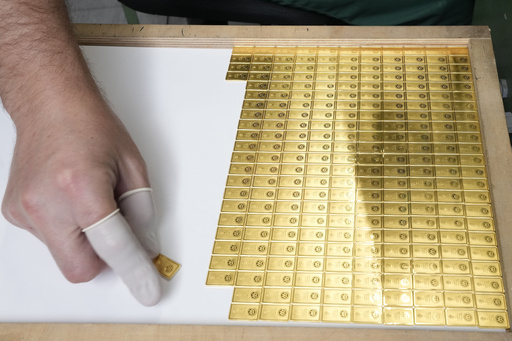WARSAW, Poland (AP) — When COVID-19 hit, long lines formed outside shops selling gold in Poland. Then came Russia’s full-scale invasion of Ukraine, triggering another rush for gold.
Piotr Kozik, the manager of a Warsaw shop selling gold bars and coins produced by the Mint of Poland, remembers how the day of Russia’s invasion, Feb. 24, 2022, was Fat Thursday, when Poles gorge themselves on paczki, jam-filled donuts.
“On that day there were longer lines for gold at our store than for donuts at the bakery,” Kozik said.
Poles were shaken by the war across the border, which sent refugees fleeing to their country, and to many gold seemed to offer financial and psychological security.
Today those lines are gone, but demand for gold remains steady as the war rages on into its third year. Adding to unease is a migration crisis at Poland’s border with Belarus, which Polish authorities view being engineered by the governments of Russia and Belarus.
Radoslaw Paklikowski, a 38-year-old entrepreneur in the western Polish city of Wroclaw, began buying gold and silver coins in 2021 and now invests 5% of his assets in precious metals.
“Having real physical gold is important, and by that I don’t mean a ton of gold, but an amount that will help you cross the border or make your family safe if anything will happen,” he said.
Membership in NATO gives some a feeling of security. Still, many in this region once under Moscow’s control worry that if Russia prevails in Ukraine it won’t stop there.
While governments beef up defenses and send weapons to Ukraine, regular people are seeking protection. Some with means have bought homes in Spain and Italy.
Unlike investments in real estate or artwork in Poland, gold, diamonds and silver can be easily moved.
In Poland, gold’s allure is intertwined with the enduring trauma of World War II, when it could ensure survival.
Stories are still told in families of relatives who survived thanks to gold jewelry or coins which allowed them to buy food or cross borders to safety when the country was under occupation by German and Soviet forces. Nearly 6 million Polish citizens were killed in that war, among them most of Poland’s Jews.
Marta Bassani-Prusik, head of precious metals trade at the Mint of Poland, said her clients include Poles who recall such family histories, as well as people with Polish roots who return to see the land of their ancestors, some of whom fled the Warsaw Ghetto.
“They say that they are alive only because of the gold, because their grandparents had a gold bar or a gold coin,” she said.
She said the market for investment gold bars and coins was slow in the years before COVID-19, but took off with the pandemic and war “because everybody was afraid of what was happening.”
Just when the gold market was leveling off, it got another boost from post-pandemic inflation, which reached over 18% in Poland.
The price of gold is volatile like stocks and investors can lose if they buy high and have to sell low, and it can get lost or stolen. Since it is priced in dollars on a global market, like oil, currency fluctuations can add to the risks for some.
That it remains attractive attests to its universal allure, and gold has surged from around $1,300 per Troy ounce — which is 31 grams and the standard for measuring precious metals — to over $2,300 over the past decade.
The rise is increasingly driven by demand from individuals and central banks in Asia, according to Michal Teklinski, an expert at Goldsaver, a popular new branch of investment gold dealer Goldenmark Group that allows clients to buy physical gold in instalments.
Teklinski predicts prices will continue to rise in coming years because central banks in China and many emerging markets are increasing their gold reserves.
Amid the global boom, the market for physical gold in Poland has been one of the strongest in Europe after 2020, only after Germany, Switzerland and Austria, fueled by rising wealth and a distrust of authorities. “After 2020, people started to go back to their roots,” he said.
The Mint of Poland, which has operated since 1766, was once a state venture but was privatized after the fall of communism and is now listed on the Warsaw Stock Exchange. It retains the sole right to produce circulation coins for Poland. It also mints coins for countries around the world, from Paraguay to Ireland and Luxembourg to Thailand.
The company says its gold comes from Polish mines and is ethically sourced and produced, meaning human rights and environmental protection are respected.
At the Mint of Poland shop in downtown Warsaw, set amid skyscrapers on soil where the Warsaw Ghetto once existed, the price of gold is updated throughout the day on a screen.
On a recent afternoon, a 40-year-old business owner, Marcin Grzesiak, walked in and ordered up three gold coins. He handed over 29,000 Polish zlotys ($7,000) in cash and slipped the coins in his pocket.
Grzesiak, who lives in eastern Poland near the Belarus border, said he wants to diversify his investments due to his concerns about the geopolitical situation and the threat cyberattacks pose to global financial stability.
“We are living in turbulent times,” he said. “I didn’t expect Russia to attack Ukraine. Even my friends from Ukraine didn’t expect Russia would attack them. Anything can happen.”
This website uses cookies so that we can provide you with the best user experience possible. Cookie information is stored in your browser and performs functions such as recognising you when you return to our website and helping our team to understand which sections of the website you find most interesting and useful.
